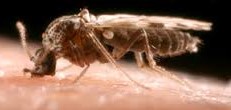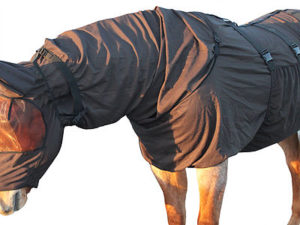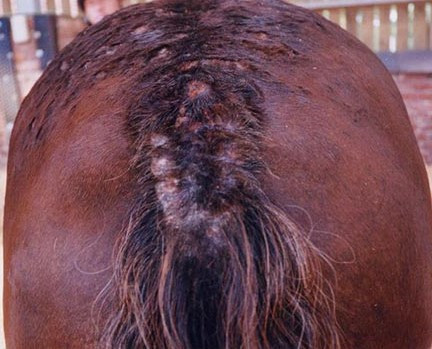We are coming to the time of year when biting insects start to emerge - as the weather warms up. After last year when we think overall we saw a lot less sweet itch than usual, this year some yards have seen insects in the very warm spell we had in February! And prevention and being ready is always important.
What causes sweet itch?
Horses can have reactions to various insects - everyone will have seen lumps caused by bites from insects for example horse fly bites.
 Sweet itch is usually caused by the bite of the Culicoides midge, specifically exposure to their saliva. In some horses their immune system overreacts with a hypersensitivity reaction that cause a strong reaction to the insect (releasing histamine) causing swelling and itching.
Sweet itch is usually caused by the bite of the Culicoides midge, specifically exposure to their saliva. In some horses their immune system overreacts with a hypersensitivity reaction that cause a strong reaction to the insect (releasing histamine) causing swelling and itching.
The horse will start to rub and chew at the area - which makes it even more inflamed and itchy - rubbing out hair, making skin raw and in some cases can even lead to infections. This happens mostly where the horse is bitten more - usually along the mane, head of tail, and occasionally head, neck, shoulders and the underside of the belly. The location can vary if another insect is causing the problem.
The more a horse is bitten and the more the horse rubs the worse the problem will become.
How to prevent it...
This is very difficult and with very sensitive horses can be impossible.
Some possible things that may help include:
 avoid the midges!
avoid the midges!- a windy hillside avoiding: too much stationary water where midges breed and woodland and high hedges where midges congregate. These will help - but will not be possible for many.
- stabling your horse around dawn and dusk the times midges are more active
- use a full body fly sheet which includes the neck and belly can prevent midges from biting, but everyone with a sweet itch horse will know with your horse rubbing they will regularly destroy them!
- use fly screens on your stable door / windows
- use a fan in the stable - midges will mass in sheltered areas with little wind
- insecticide sprays on the stables and screens can also help
- insect repellent - containing pyrethroid or permethrin-containing products are generally the most effective - we find Deosect or Switch/Z-Itch can help giving protection for up to 2 weeks. DEET can help but can cause skin reactions
- Cavalesse is a food supplement containing nicotinamide (a type of Vitamin B3), which is known to reduce histamine production and improve the skin lipid (oil) barrier
- desensitisation injections containing extracts of midge saliva are given as repeated injections into the skin (often called immunotherapy) may be effective
Treatments
Although we always aim to prevent horses from reaching this point. Many of these treatments are to help get the itch back under control and to a point where the preventative measures work again. Some of them can have side effects which we will discuss with you.
We may consider some of the following:
- topical anti-itch washes
- application of ice or cold hosing for short term immediate relief
- antihistamines can help in some horses but they do very little for a lot of horses
- steroids - are usually effective in 'dampening down' the reaction - and are usually given by an initial injection followed by an oral treatment. These supress the immune system and are used at the lowest dose possible, but are not ideally used in the long term
Remember - we can advise on treatments and management - but they all must include preventing midges biting in the first place. Please also remember that no treatments are universally effective - don't believe ones that say they are!
Adam x

